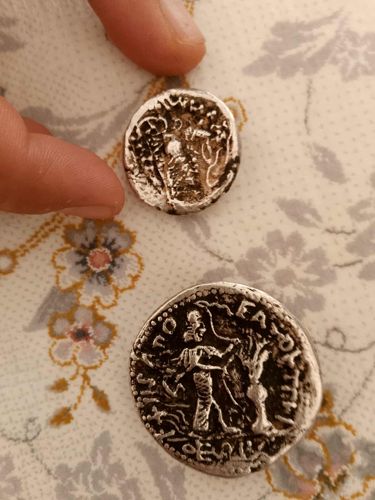Ancient Greek Tetradrachm, Late Classical Period
Country of Origin: Ancient Greece (likely Attica, Athens)
Year of Issue: Circa 440-404 BCE
Denomination: Tetradrachm
Composition: Silver

Brief Description
The coin on the bottom appears to be an Athenian tetradrachm (or a replica thereof), known for its iconic design. The obverse typically features the head of Athena wearing a crested Attic helmet. The reverse commonly displays an owl (the symbol of Athena) with an olive sprig and a crescent moon, and the inscription 'ΑΘΕ' (for 'Of the Athenians'). The coin on the top is less clear but also appears to be an ancient Greek or Roman silver coin, possibly a smaller denomination or different mint. The depiction on the visible side of the top coin is difficult to ascertain from the image quality.
Historical Significance
The Athenian Tetradrachm was one of the most widely circulated and influential coins of the ancient world, serving as a primary currency for trade across the Mediterranean. Its consistent design and high silver purity fostered trust and stability in economic transactions. It represents the height of Athenian power and cultural influence during the Classical period and is often associated with the 'Golden Age of Athens' under Pericles. The owl symbolism connects to wisdom and prosperity.
Estimated Value
Given that these coins might be replicas due to their relatively sharp details and the common practice of reproducing famous ancient coins, their value could range from very low (for modern replicas, e.g., $10-$50) to significant (if authentic and well-preserved, potentially thousands to tens of thousands of dollars, depending on rarity, condition, and specific type). Without in-hand inspection and expert authentication, a precise value is impossible. The image quality makes definitive authentication challenging.
Care Instructions
Handle coins by the edges to avoid touching the surfaces, as oils from skin can cause damage over time. Store in inert, archival-safe holders (e.g., Mylar flips or non-PVC plastic slabs) away from direct sunlight, extreme temperatures, and humidity. Do not clean ancient coins unless advised by a professional conservator, as cleaning can significantly devalue them by removing natural patina and potentially damaging the surface. If these are replicas, care is less critical but still advisable for preservation.
Created At: 2025-09-06T11:02:06.387552